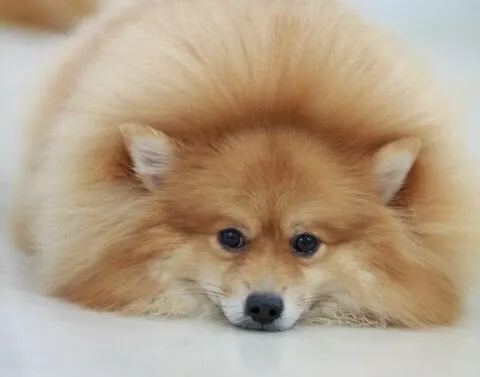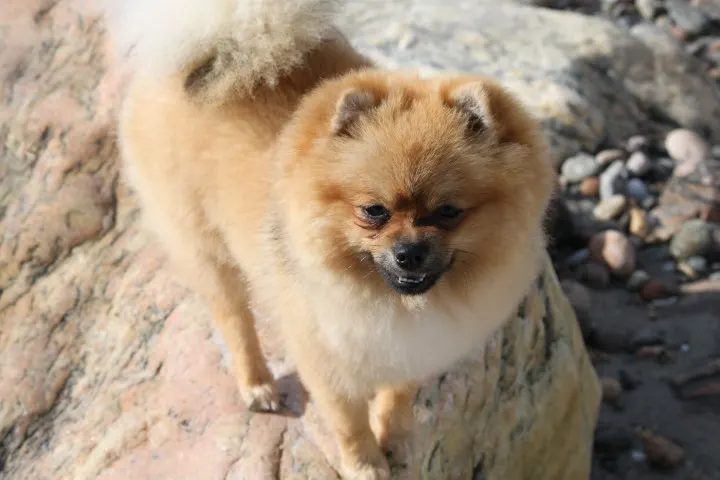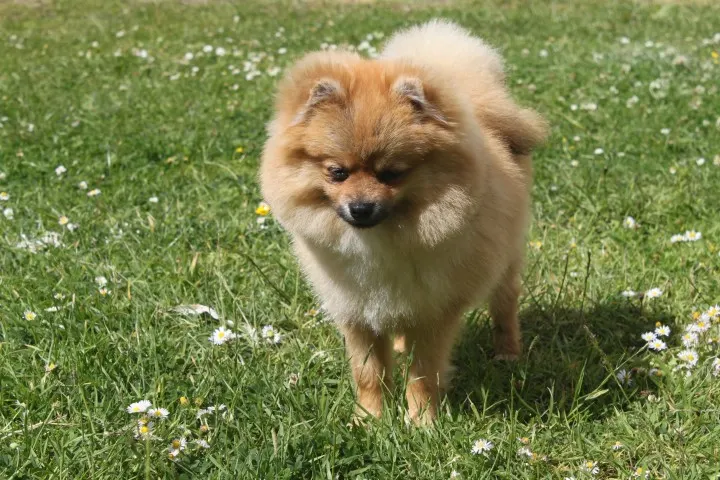The Pomeranian is an adorable small dog that can quickly turn heads with its beautiful, full coat. This little dog is an attractive companion, but don’t be fooled by looks alone.
The Pomeranian is also intelligent, loyal, and affectionate, making it the perfect family dog.
 With fur galore, the Pomeranian is not a hypoallergenic dog. The thick coat of the Pomeranian is prone to shedding, which can trigger allergies.
With fur galore, the Pomeranian is not a hypoallergenic dog. The thick coat of the Pomeranian is prone to shedding, which can trigger allergies.
This dog has plenty of allergy-causing proteins, and it also has the ability to attract spores, pollen, and dust on its thick coat, which can further aggravate allergies.
Even though a Pomeranian may not be the best choice for people who suffer from allergies, a Pomeranian mix might be suitable.
A popular hybrid designer dog called a Pomapoo mixes a Pomeranian and a Poodle. This combination can be a hypoallergenic dog, with the Poodle genes for hypoallergenic fur often transferred to the offspring.
If you suffer from allergies but are attracted to the Pomapoo breed, talk to the breeder about how hypoallergenic other litters have been in the past.
What Causes Allergies From Dogs?
 It may seem like allergies stem straight from the dog, but really allergies come from proteins that the dog creates. Proteins that cause allergies are most commonly found in fur and dander that the pet sheds.
It may seem like allergies stem straight from the dog, but really allergies come from proteins that the dog creates. Proteins that cause allergies are most commonly found in fur and dander that the pet sheds.
Although this is the most common source of allergy-causing proteins, proteins are also found in pet saliva, feces, and urine.
Because the most common source of protein in dogs is in the fur and dander, this source is often the focus of pet allergies. Dogs that shed less than usual are often better for people who suffer from allergies.
Exceptionally light shedders are called hypoallergenic because these dogs are the least likely to trigger an allergic reaction from their fur and dander.
What Are Common Allergy Symptoms?
Nearly 10% of all Americans are allergic to dogs. The majority of people react to dog fur and dander, but some people are also allergic to saliva and urine.
Allergies are typically mild to moderate, but severe allergies can be life-threatening if left untreated. Some of the most common symptoms of dog allergies include:
- Runny or Stuffy Nose
- Congestion
- Facial Pain or Swelling
- Rash or hives
- Itchy or Watery Eyes
- Coughing, Wheezing, or Shortness of Breath
Most symptoms associated with allergies can easily be treated with simple over-the-counter antihistamines or allergy medication.
If you experience severe symptoms, remove yourself from the environment with pet dander or fur. If symptoms do not improve or worsen over time, seek medical attention for your allergic reaction.
How Can I Treat Dog Allergies?
 If you suffer mild allergy symptoms when you come in contact with a dog or dog fur, you may be able to manage your allergies with over-the-counter medication.
If you suffer mild allergy symptoms when you come in contact with a dog or dog fur, you may be able to manage your allergies with over-the-counter medication.
Consider taking an allergy medication or antihistamine to combat the allergic reaction your body encounters.
Rinsing your nasal passageway with saline once per day can also help mitigate allergies. Rinsing your nasal passage can help remove built-up allergens, which can cause pet allergies to worsen over time.
In some cases, using a mild steroid prescribed by a doctor can help manage allergies.
There are also allergy shots available, but these can take months to build up in your system, with weekly shots, to eliminate pet allergy symptoms effectively.
Do Pomeranians Shed?
Even though the Pomeranian is a small dog, it is a profuse shedder. This little dog is a member of the Spitz family, which is known for particularly thick and wooly coats.
The Pomeranian has very thick hair that sheds year-round. Aside from hair and dander, a Pomeranian’s coat is so dense that it can be a magnet for pollen and dust, triggering allergies in people who are generally fine around dogs.
Expect a particularly bad shedding period twice per year. This heavy shedding period usually coincides with the changing seasons.
The Pomeranian will have a heavy shed as the seasons transition from winter to spring and from summer to fall. Expect each heavy shedding period to last for about two weeks.
Can Grooming Help Prevent Pet Allergies?
 Grooming your Pomeranian can help manage your allergies. Grooming is a great way to help remove dead and loose hairs from your Pomeranian’s thick coat.
Grooming your Pomeranian can help manage your allergies. Grooming is a great way to help remove dead and loose hairs from your Pomeranian’s thick coat.
You’ll want to brush your Pom about three times per week. Be sure you are using the right brush to make the most significant impact. You want to use a deep metal comb to ensure you are getting through all the layers of the Pomeranian coat.
Bathing your Pomeranian periodically will also help reduce allergens in your home. Your Pom should be bathed about every six to eight weeks. You always want to use a moisturizing and natural shampoo.
Be wary of shampoos advertised as anti-shed or shed eliminators. Bathing your Pomeranian too often can actually cause more shedding because it dries the skin causing hair to fall out more quickly.
Can A Pomeranian Mix Be Hypoallergenic?
Designer dog breed mixes are an excellent way to get the best attributes from two independent dog breeds. There are several Pomeranian mixes available that capture some of the Pomeranian’s best qualities.
Although a Pomeranian is not a hypoallergenic dog, some combinations might help reduce shedding, creating a more allergy-friendly dog mix.
Stay away from some popular Pomeranian mixes that feature other heavy-shedding dogs. The Pomsky, a combination of a Husky and a Pomeranian, is adorable and a recipe for disaster for allergy sufferers.
Focus your efforts on designer mixes that feature hypoallergenic dogs like Poodles. The Pomapoo is a loving and affectionate mix that could potentially be a light-shedding option.
Will A Pomapoo Be Hypoallergenic?
 Although a Pomapoo is a mix of a Pomeranian with a hypoallergenic dog breed, nothing guarantees that the offspring will inherit all the hypoallergenic qualities of the Poodle parent.
Although a Pomapoo is a mix of a Pomeranian with a hypoallergenic dog breed, nothing guarantees that the offspring will inherit all the hypoallergenic qualities of the Poodle parent.
Further, every puppy will be different, as dogs inherit different traits from the mother and father dogs.
Always check with the breed before adopting a Pomapoo to learn if other offspring have been hypoallergenic.
Your breeder will be able to give you a good idea of how much shedding you can expect from your puppy. You will usually know at about 12 weeks of age whether a Pomapoo will have hypoallergenic qualities.
Of course, it is always a good idea to spend time with the dog you plan on adopting to ensure your new family member does not trigger an allergic reaction.
What Are Other Small Hypoallergenic Dogs?
Even though a Pomeranian may not be the best choice for allergy sufferers, there are plenty of small dogs that may be better suited.
While no dog will be completely hypoallergenic, plenty of dogs will only lightly shed, reducing the chance of allergic reactions. Some great hypoallergenic alternatives to the Pomeranian include:
- Miniature Schnauzer – This little dog is the pint-sized cousin of the Standard Schnauzer. The soft and curly fur is very resistant to shedding, making this an excellent option for people with pet allergies.
- Maltese – The Maltese is a small, loving, and beautiful dog. This dog breed has soft fur that rarely sheds, making it a wonderful hypoallergenic option. Maltese pups are relatively low energy, making them perfect for urban life or apartment dwellers.
- Lhasa Apso – Even though the Lhasa Apso has long fur, it is considered a hypoallergenic dog. The long fur is more closely related to human hair and rarely sheds.
- American Hairless Terrier – One of the most hypoallergenic options for a dog, the American Hairless Terrier is completely without fur. Just because this little dog doesn’t have fur doesn’t mean it is maintenance-free. The dog will still require regular grooming to keep its skin healthy and oil-free.
- Yorkshire Terrier – If you are looking for a little dog with a big personality, the Yorkshire Terrier is a perfect option. Friendly, boisterous, and brave, the Yorkshire Terrier is a long-haired dog that is considered hypoallergenic.
Related Questions
Can Pomeranians be service dogs?
 Just because these dogs are small, it doesn’t mean they aren’t mighty. The Pomeranian is an excellent service dog that is versatile and adaptable. Some standard services these dogs can perform include:
Just because these dogs are small, it doesn’t mean they aren’t mighty. The Pomeranian is an excellent service dog that is versatile and adaptable. Some standard services these dogs can perform include:
- Help for the hearing impaired or deaf, alerting to a crying baby, doorbell, or telephone ring.
- Assist in moving objects around the house, such as fetching a remote or opening drawers and cabinets.
- Alert dogs for psychiatric disorders like autism or social anxiety.
- Medical alert animals that can be used for detecting seizures or changes in glucose levels.
How big do Pomeranians get?
Pomeranians are petite dogs that are excellent choices for a small apartment or home. At full size, these little dogs only reach about 7 to 12 inches tall at the shoulder. The dog usually weighs between 3 and 7 pounds.
Some Pomeranians are larger, much like their ancestors, and can reach up to 14 pounds, but these larger dogs are not consistent with the modern breed standard.
Our team is composed of pet care professionals, veterinarians, and pet owners. To date, we’ve conducted thousands of hours of research to publish the most accurate pet information.
Most of the writers on our site are vets with 10+ years of clinical experience, ranging from small practice, to equine practice, academia, and surgery. Our goal is to help every pet owner get the information they seek about their dear companions.



Leave a comment
You must be logged in to post a comment.